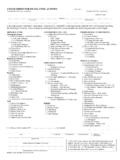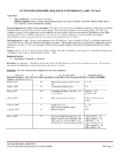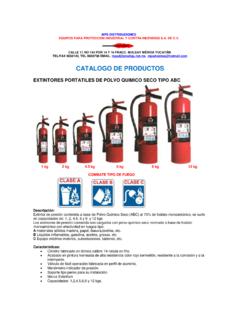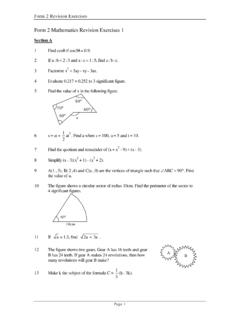Transcription of An Equation for the Prediction of Oxygen …
1 An Equation for the Prediction of Oxygen consumption in a brazilian PopulationAntonio Eduardo Monteiro de Almeida1,2, Charles de Moraes Stefani3, Jo o Agnaldo do Nascimento2, Narla Miranda de Almeida1,2, Amilton da Cruz Santos2, Jorge Pinto Ribeiro (in memoriam)4, Ricardo Stein3,4,5 Cardio L gica M todos Gr ficos1; Departamento de Educa o F sica e Departamento de Estat stica da Universidade Federal da Para ba UFPB2, Jo o Pessoa, PB; Grupo de Pesquisa em Cardiologia do Exerc cio do Hospital de Cl nicas de Porto Alegre3; Servi o de Cardiologia do Hospital de Cl nicas de Porto Alegre - Universidade Federal do Rio Grande do Sul4; Vitta Centro de Bem-Estar F sico5, Porto Alegre, RS - BrazilMailing Address: Ricardo Stein Rua Jo o Caetano 20/402, Petr polis.
2 Postal Code 90470-260, Porto Alegre, RS BrazilE-mail: received March 16, 2014; revised manuscript May 27, 2014; accepted June 25, : : The equations predicting maximal Oxygen uptake (VO2max or peak) presently in use in cardiopulmonary exercise testing (CPET) softwares in Brazil have not been adequately validated. These equations are very important for the diagnostic capacity of this : Build and validate a brazilian Equation (BE) for Prediction of VO2peak in comparison to the Equation cited by Jones (JE) and the Wasserman algorithm (WA).
3 Methods: Treadmill evaluation was performed on 3119 individuals with CPET (breath by breath). The construction group (CG) of the Equation consisted of 2495 healthy participants. The other 624 individuals were allocated to the external validation group (EVG). At the BE (derived from a multivariate regression model), age, gender, body mass index (BMI) and physical activity level were considered. The same Equation was also tested in the EVG. Dispersion graphs and Bland-Altman analyses were : In the CG, the mean age was years, were male, the average BMI was , and the physical activity distribution level was: sedentary, active and athletes.
4 An optimal correlation between the BE and the CPET measured VO2peak was observed ( ). On the other hand, difference came up between the average VO2peak expected by the JE and WA and the CPET measured VO2peak, as well as the one gotten from the BE (p = ).Conclusion: BE presents VO2peak values close to those directly measured by CPET, while Jones and Wasserman differ significantly from the real VO2peak. (Arq Bras Cardiol. 2014; [online].ahead print, )Keywords: Oxygen consumption ; Forecasting; Respiratory Function Tests; population ; maximum capacity of an individual to perform aerobic work is defined by the maximum Oxygen consumption (VO2max or VO2peak), which is the product of cardiac output and arteriovenous Oxygen difference during maximal effort1.
5 The integrated responses of the respiratory, cardiovascular, and muscular systems in exercises involving large muscle groups increase up to a certain limit, which defines VO2peak or the maximum aerobic condition of the individual2. Several factors affect VO2peak determination, including age, gender, genetics, ethnicity, body composition, physical activity level, and exercise type3. VO2peak provides important diagnostic and prognostic information in various clinical situations.
6 Classical studies using large samples of middle-aged and older people from different parts of the world have repeatedly found that the risk of mortality due to all causes in age groups ranging from 5 to 20 years can vary from 1 5-fold for individuals placed in the most extreme quartiles or quintiles of VO2peak4-9. Furthermore, VO2peak is an important independent prognostic marker in heart failure and is used as the indication criteria for cardiac can be calculated directly by the measurement of exhaled gases during cardiopulmonary exercise testing (CPET) or can be estimated using equations.
7 According to Bruce et al13, in a Prediction Equation , VO2peak is dependent on pretest physical characteristics, such as gender, age, physical activity level, weight, and height. In turn, in an estimation Equation , VO2peak is dependent on variables obtained during an exercise test (treadmill test), including speed, inclination, load, duration, and heart rate. For the Prediction or estimation Equation , it is important to understand the structural and local characteristics of the population for which the Equation is created or validated; such equations are created with the goal of obtaining a VO2peak value closest to the actual Oxygen Almeida et national Equation for maximal Oxygen consumptionArq Bras Cardiol.
8 2014; [online].ahead print, ,14. The VO2peak values measured directly with CPET can be compared with the VO2peak values predicted for a particular age group3. Of note is that the Prediction of VO2peak for normality is commonly performed using equations that are not validated for the brazilian population . The two equations most often used in CPET softwares in Brazil include the Equation reported by Jones and Campbell15, which has been modified for the treadmill, and the Prediction algorithm of Wasserman et al3.
9 There is empirical evidence16 that these equations overestimate the predicted VO2peak values when compared with direct measurements performed with CPET. Therefore, the present study aimed to construct and validate an Equation derived from the brazilian population to predict VO2peak and to compare this Equation with the Equation of Jones and Campbell15 and the algorithm of Wasserman et sampleA total of 5,382 individuals from across the state of Para ba were evaluated. These individuals were referred to a private clinic considered as a reference for CPET in the city of Jo o Pessoa and for the performance and evaluation of CPET between February 2007 and January 2013.
10 Figure 1 shows the flowchart for study group the total sample, 2,066 individuals were excluded based on the following criteria: 227 did not undergo complete blood count and 2D-color Doppler echocardiography while performing CPET and 1,839 patients were diagnosed with hypertension and are on medication ( ), coronary artery disease ( ), heart failure ( ), valvular heart disease ( ), anemia ( ), chronic obstructive pulmonary disease ( ), and asthma ( ). The normal group comprised 3,316 individuals, of which 188 were excluded because they did not reach the maximum test criterion and/or because of the lack of agreement on VO2peak measurements between evaluators.
















